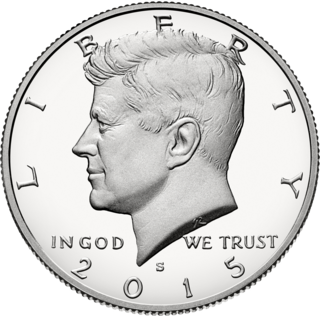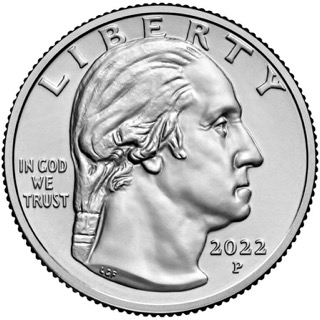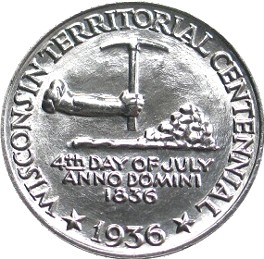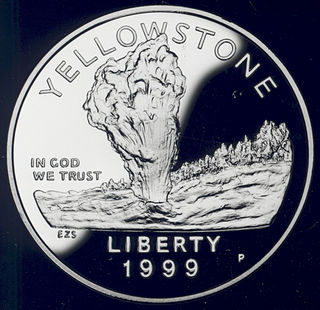Coins of the United States dollar, aside from those of the earlier Continental currency were first minted in 1792. New coins have been produced annually and they make up a valuable aspect of the United States currency system. Circulating coins exist in denominations of 1¢, 5¢, 10¢, 25¢, 50¢, and $1.00. Also minted are bullion, including gold, silver and platinum, and commemorative coins. All of these are produced by the United States Mint. The coins are then sold to Federal Reserve Banks which in turn are responsible for putting coins into circulation and withdrawing them as demanded by the country's economy.

The United States Mint is a bureau of the Department of the Treasury responsible for producing coinage for the United States to conduct its trade and commerce, as well as controlling the movement of bullion. The U.S. Mint is one of two U.S. agencies that produce money in the case of minting coinage; the other is the Bureau of Engraving and Printing, which prints paper currency. The first United States Mint was created in Philadelphia in 1792, and soon joined by other centers, whose coins were identified by their own mint marks. There are currently four active coin-producing mints: Philadelphia, Denver, San Francisco, and West Point.

The half dollar, sometimes referred to as the half for short or 50-cent piece, is a United States coin worth 50 cents, or one half of a dollar. In both size and weight, it is the largest United States circulating coin currently produced, being 1.205 inches in diameter and 0.085 in (2.16 mm) in thickness, and is twice the weight of the quarter. The coin's design has undergone a number of changes throughout its history. Since 1964, the half dollar depicts the profile of President John F. Kennedy on the obverse and the seal of the president of the United States on the reverse.
The United States Mint has minted numerous commemorative coins to commemorate persons, places, events, and institutions since 1848. Many of these coins are not intended for general circulation, but are still legal tender. The mint also produces commemorative medals, which are similar to coins but do not have a face value, and therefore are not legal tender.
The Freedom Tower Silver Dollar is a "one dollar" coin minted under license of the Commonwealth of the Northern Mariana Islands (CNMI) in 2004, although the CNMI does not have legal authority to issue or authorize currency. Despite vague statements in advertisements, it is not issued by the United States Mint and is not considered legal tender, nor is it considered non-circulating legal tender. The CNMI receives royalty fees from proceeds of the sale of the coin. The coin is actually minted by SoftSky, a Wyoming commemorative coin maker.

National Collector's Mint, Inc. is a Westchester County New York based company that sells privately produced coins, tokens, commemoratives, and collectibles, as well as anti-aging skin products through the BioLogic brand. The company does not produce coins that are legal tender in the United States and is not affiliated, endorsed, or licensed by the U.S. government or the United States Mint. However, the company does also act as a retailer, reselling government proof coins and other legal tender. The mint also creates non-currency coins for large corporations. After National Collector's Mint was repeatedly cited by state and Federal authorities for fraudulent profiteering from the 9/11 attacks, The Huffington Post described the company as a "bogus 9/11 coin seller."

The American Silver Eagle is the official silver bullion coin of the United States.

The Morgan dollar is a United States dollar coin minted from 1878 to 1904, in 1921, and beginning again in 2021 as a collectible. It was the first standard silver dollar minted since the passage of the Coinage Act of 1873, which ended the free coining of silver and the production of the previous design, the Seated Liberty dollar. It contained 412.5 Troy grains of 90% pure silver. The coin is named after its designer, United States Mint Assistant Engraver George T. Morgan. The obverse depicts a profile portrait representing Liberty, modeled by Anna Willess Williams, while the reverse depicts an eagle with wings outstretched. The mint mark, if present, appears on the reverse above between D and O in "Dollar".

The Kennedy half dollar, first minted in 1964, is a fifty-cent coin issued by the United States Mint. Intended as a memorial to the assassinated 35th president of the United States John F. Kennedy, it was authorized by Congress just over a month after his death. Use of existing works by Mint sculptors Gilroy Roberts and Frank Gasparro allowed dies to be prepared quickly, and striking of the new coins began in January 1964.

The West Point Mint is a U.S. Mint production and depository facility erected in 1937 near the U.S. Military Academy in West Point, New York, United States. As of 2019 the mint holds 22% of the United States' gold reserves, or approximately 54,000,000 troy ounces (1,700,000 kg). The mint at West Point is second only to the gold reserves held in secure storage at Fort Knox. Originally, the West Point Mint was called the West Point Bullion Depository. At one point it had the highest concentration of silver of any U.S. mint facility, and for 12 years produced circulating Lincoln cents. It has since minted mostly commemorative coins and stored gold.

The Washington quarter is the present quarter dollar or 25-cent piece issued by the United States Mint. The coin was first struck in 1932; the original version was designed by sculptor John Flanagan.

The Wisconsin Territorial Centennial half dollar is a commemorative half dollar designed by David Parsons and Benjamin Hawkins and minted by the United States Bureau of the Mint in 1936. The obverse depicts a pick axe and lead ore, referring to the lead mining in early Wisconsin, while the reverse depicts a badger and the territorial seal.

The York County, Maine, Tercentenary half dollar is a 50-cent commemorative coin minted in 1936 to mark the tercentenary of the founding of York County, Maine. The obverse shows Brown's Garrison, the fort around which York County was formed, while the reverse depicts the county's arms.

The Apollo 11 50th Anniversary commemorative coins were issued by the United States Mint in 2019 to commemorate the 50th anniversary of the first crewed landing on the Moon by Apollo 11 astronauts Neil Armstrong and Buzz Aldrin. Consisting of a gold half eagle, two different sizes of silver dollars, and a copper-nickel clad half dollar, each of the four was issued in proof condition, with all but the larger silver dollar also issued in uncirculated. The gold coins were struck at the West Point Mint, the silver at the Philadelphia Mint and the base metal half dollars at the mints in Denver and San Francisco.

The Yellowstone National Park silver dollar is a commemorative coin issued by the United States Mint in 1999. Proceeds benefitted Yellowstone National Park and other national parks via the National Park Foundation.
The Christopher Columbus Quincentenary commemorative coins are a series of commemorative coins which were issued by the United States Mint in 1992 for the Columbus Quincentenary.
The Mount Rushmore Anniversary commemorative coins are a series of commemorative coins which were issued by the United States Mint in 1991. The coins honored the 50th anniversary of the completion of Gutzon Borglum's colossal sculpture, the Shrine of Democracy, at the Mount Rushmore National Memorial. The statue and the coins feature George Washington, Thomas Jefferson, Theodore Roosevelt, and Abraham Lincoln.
The United States Capitol Visitor Center commemorative coins are a series of commemorative coins which were issued by the United States Mint in 2001.













